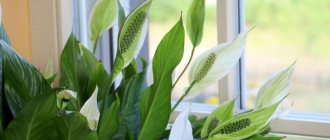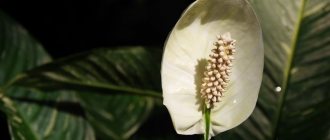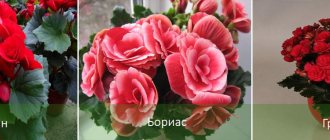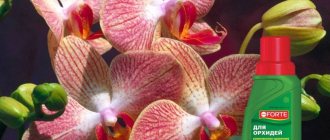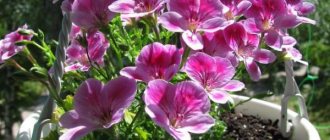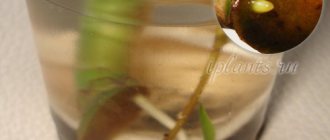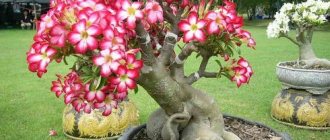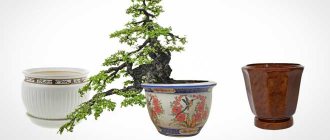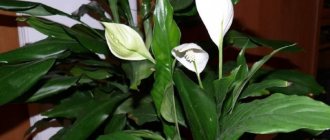It is believed that spathiphyllum or “female happiness” is a real vacuum cleaner; it perfectly cleans the air of dust and harmful fumes, and reduces the harm from radiation from office equipment. Therefore, it is recommended to start it in offices, and at home to place it in the living room or office, where there is a computer and TV. In addition, there is evidence that this plant absorbs formaldehyde from the air. (1) Considering the unpretentiousness of the flower and the ability to bloom almost continuously, the popular love for this native of South America becomes understandable.
- if a single woman plants a flower, she will soon find her feminine happiness (that’s why spathiphyllum is called that);
- spathiphyllum improves the energy of the house and is able to give the owners well-being and happiness;
- a flower is a kind of barometer of mood - if there are frequent scandals and quarrels in the house, there is no mutual understanding, then the flower begins to dry out, stops blooming and may die;
- if spathiphyllum blooms in your house, then very soon you may have a long-awaited baby - it is believed that this flower helps even those women who have already despaired of becoming a mother.
Of course, these are all nothing more than myths, but we’ll tell you only the truth about how to care for them.
Types of flower female happiness (spathiphyllum)
The genus Spathiphyllum from the Araceae family includes about 50 species. (2) Only a few of the most unpretentious ones are grown at home.
Spathiphyllum wallisii. This species was discovered in Colombia at the end of the 19th century. The species is named after Gustov Willis, a German plant collector. The plant reaches a height of 60 cm, its leaves are large, up to 25 cm (and the petiole is the same length), glossy, with spectacular wavy edges. Blooms in late autumn or winter. The flower is a yellow spadix with a white spathe, which over time acquires a pale green hue.
Within this species, about 40 varieties have been bred, which differ in size, shape of leaves and inflorescences.
- Domino (Domino) - about 50 cm high with variegated leaves: numerous white spots and specks are scattered on a dark green background, a white blanket, a flower with a faint pleasant aroma;
- Gemini . This variety is a variegated mutation of the Domina variety. Its leaves are dark green with numerous light spots;
- Picasso - with numerous large white strokes on a green background, some leaves are almost completely white, the spathe is white;
- Chopin is one of the most popular varieties, about 35 cm high, with elongated green glossy leaves, a flower with a white cover and a pleasant aroma;
- Mauna Loa - with large dark green leaves up to 20 cm long and a large white blanket.
View of Picasso. Photo: pexels.com
View of Chopin. Photo: pexels.com
Another popular species comes from Colombia. The plant is up to 50 cm high with large leaves up to 25 cm long. They have a beautiful velvety dark green color. Up to 40 leaves are formed on one plant. The cob is creamy, the spathe is first white and then turns green. It blooms profusely - with good care, a flower bud is formed in the axil of each leaf, therefore, there can be up to 40 flowers.
Spathiphyllum heliconiifolium. This species is native to the tropical forests of Brazil. The plant is very large, up to 1 m high with leaves up to 50 cm long. They are dark green, glossy, wavy at the edges. The cob is up to 10 cm long, at first white, and then darkens almost to black. The spathe is white, oval, almost twice as long as the cob.
Spathiphyllum cannifolium. Originally from Venezuela. Its leaves are similar to those of popular garden flowers - cannas. They reach a length of 80 cm, velvety, bright green. The cob is yellow-green, the spathe is white-green. The flowers are fragrant.
Spoon-shaped spathiphyllum (Spathiphyllum cochlearispathum). Native to the tropical forests of Brazil. The plant is large, about 1 m high. The leaves are up to 40 cm long, dark green, glossy, on long petioles. The cob is white, the spathe is also white, oval, shaped like a spoon - hence the name of the species.
Pleasant spathiphyllum (Spathiphyllum blandum) . This species is native to the tropical forests of Africa. Its leaves are dark green, up to 30 cm long. The cob is large, up to 20 cm long, the spathe is white-green. It grows slowly, but blooms very profusely.
This species came to us from tropical Africa. The bushes are larger than those of the Abundantly flowering one. Its leaves are elongated-lanceolate, with a retracted tip, and dark green in color. Strong long petioles. The inflorescence has a spadix surrounded by a greenish-white spathe, similar in shape to a small flag. It is this variety of Female Happiness that is popularly called Flagolist. Flowering is abundant and lasts from April to June. With good care it can bloom twice a year. It is unpretentious in everyday life, grows well in shade, although the annual growth is small.
Step by step transplant instructions
- Before replanting, you need to ensure that the flower is watered along the edge of the pot. When the water is absorbed, very carefully remove the plant, being careful not to damage the roots.
- Check the roots for integrity. Cut out damaged and rotten elements with scissors. Be sure to sprinkle with activated carbon and dry.
- Transfer to a prepared pot (with drainage and soil), placing it in the center. Add soil to the missing areas. Add water.
- Add soil as it settles after absorbing water. Spray the leaves with water. Home sprayers are used for this. It is better to add a drop of any growth stimulant to the water. This will help relieve stress in the plant.
- Check for stability so that it does not fall over.
With this replanting, the rhizomes will be able to use the nutrients throughout the pot. This method does not involve completely replacing the soil. The plant itself does not suffer during such a transplant.
Important! This method cannot be used for a newly acquired plant!
The transplanted “female happiness” is kept in a shaded place for a week, then transferred to a designated place.
Varieties of the flower female happiness (spathiphyllum)
We have already mentioned 4 varieties that are traditionally classified as Spathiphyllum Wallis. However, there are others that are no less interesting. But it is difficult to classify them as any species - these are hybrids with the participation of many parents.
Alana . _ The hybrid is about 50 cm high. Its leaves do not droop, like many other varieties and hybrids, but stand almost vertically. Their color is rich green. The cover is white, but towards the end of flowering it turns green.
Verdi . _ A tall variety (up to 70 cm) with bright green leaves and a large pure white spathe. Whimsical, requires constant care.
Caiti . _ A very unusual cultivar, similar to the Domino variety, but on its leaves the blotches and streaks are not white, but yellow. Plant up to 60 cm high.
Sensation . _ A very large variety, with leaves up to 75 cm long and about 40 cm wide, dark green, wavy.
Sweet Silvio . A large hybrid with a large number of dark green leaves, making the bush look very lush. And its flower stalks are graceful.
Alan variety. Photo: pixabay.com
Caring for the flower of female happiness (spathiphyllum) at home
We talked about how to care for this flower with the chairman of the Moscow Flower Growers club, Tatyana Zhashkova.
Spathiphyllum is native to South America, which means it loves warmth. The optimal temperature for it is 18 - 25 °C. If it is lower, the plant may get sick. And this plant also does not like drafts.
Priming
In nature, spathiphyllums live in tropical forests, and the soil there is rich in organic matter. Therefore, they require fertile land to grow. The ideal composition is a mixture of turf and leaf soil, humus, peat and river sand in a ratio of 1:1:1:1:1.
Lighting
Since in nature spathiphyllum grows in the jungle, it does not tolerate direct sunlight. If bright light hits the plant directly, it can get burned, so during the sunniest hours it is better to move the plant to the shade or cover it.
Spathiphyllum tolerates shade and partial shade much more easily, but a long absence of light can affect the brightness and size of the leaves - they will be weak and small. The best option for it is an east window.
Humidity
As a native of the humid jungle, he prefers the ground to be moist, but not too wet. For spathiphyllums, special pots with built-in trays are even sold, into which water is poured and it is gradually absorbed into the lower layer of the earth. This way, harmful overflow for the flower will not occur, but moderate soil moisture will remain.
The flower also loves spraying; if you do it every day, it will reward you with bright leaves.
Fertilizers
It is best to fertilize spathiphyllums with liquid organic fertilizers with a complex of macro- and microelements.
Feeding
The “female happiness” flower needs to be fed, like all others, with complex fertilizer: once every 2 weeks in spring and summer (from April to September). And in autumn and winter it is better not to feed at all and even slightly reduce watering to give the plant a rest. If everything is done correctly, the flower will bloom all year round.
Trimming
Spathiphyllum does not require formative pruning. All you need to do is remove yellowed and dried leaves if they suddenly appear.
Reproduction of the flower of female happiness (spathiphyllum) at home
The easiest way to propagate spathiphyllum is by dividing the bush. This is best done during plant transplantation - early in the spring.
You can even divide the bush into many parts, but it is important that each division has 2 - 3 leaves and a growth point - a bud from which young leaves grow. You need to divide the roots with a sharp knife. It is advisable that the soil remains on the roots - this way the divisions will take root better.
Each part of the plant should be planted in small pots and watered very generously at first.
It is advisable to separate young rosettes from the main bush about once every 2-3 years so that the plant does not become too thick.
Transplanting the flower of female happiness (spathiphyllum) at home
Spathiphyllum loves close quarters. It is even believed that the tighter the roots are in the pot, the more abundantly it blooms. But if you see that the roots have begun to crawl out of the pot, there are too many rosettes, and the leaves are simply crowded, then it’s time to replant.
It is best to replant the flower in the spring. If the plant is replanted as a whole, the pot should be 2 cm larger in diameter. If it is divided, then the size should be proportionate to the divisions - you should not plant them in containers that are too large, you can flood the plant.
After transplanting the flower, it is better not to water it for 5 - 6 days, wait until the soil dries completely. But you need to spray twice a day, not allowing the leaves to dry out.
Initial care after
After transplantation, spathiphyllum needs high humidity in the first month. If you want the plant to acclimatize faster and enter the flowering stage, build a kind of greenhouse for it. To do this, just completely wrap the pot with spathiphyllum in a plastic bag. The entire time the plant is “under the hood”, it needs simple care: regular watering and ventilation.
For the first few weeks, cover the flower under a polyethylene cap to provide it with moisture.
Diseases of the flower female happiness (spathiphyllum)
Most often, 2 diseases occur in spathiphyllum.
Root rot. The disease can be determined by the condition of the leaves - at first they turn pale, then begin to turn yellow and wither. The cause of the disease is most often excessive soil moisture.
At the first signs of root rot, the plants should be transplanted into a new pot and fresh soil as quickly as possible, cutting out the damaged areas and disinfecting the pot.
Late blight. The first signs of the disease are rot, which appears at the base of the shoots. Then the fungus rises up the leaves, affecting the plant more and more. Diseases are provoked by too frequent and abundant watering and low air temperatures.
To treat late blight, the drugs Consento, Revus, and Ordan are used. (3)
How to choose the right pot for spathiphyllum, description, photo
When choosing a new pot, it is important to follow the rule: it should be a little larger in size compared to the previous one. It is important to comply with this condition so that the formed roots do not receive too much space during transplantation. If this condition is not met, there will be no flowering. Until the root system grows and fills the entire volume. With subsequent transplants, the volume of the pot is increased. If these conditions are met, spathiphyllum will gradually develop without additional stress.
After choosing a pot, you need to make sure there is a drainage hole. Experienced gardeners often use clay pots without drainage. This is not important for a strong and robust specimen, but a young pet will find it easier to grow with a drainage system. Place large pebbles and expanded clay in a layer of 1.5-2 cm at the bottom of the pot. Then add the same layer of soil. The pot is ready for transplanting!
Popular questions and answers
We talked with agronomist-breeder Svetlana Mikhailova about what other difficulties may await the owners of spathiphyllums .
How to choose a flower of female happiness (spathiphyllum)?
When choosing a plant, pay attention to its health - the leaves should be richly colored, without spots or signs of pests. If possible, remove the spathiphyllum from the pot and inspect the roots. If there are signs of decay or the soil smells like a swamp, it is better not to take the plant.
What kind of pot is needed for the flower of female happiness (spathiphyllum)?
Not very spacious - in large volumes, spathiphyllum soil blooms very poorly and does not last long, they like close quarters. If the plant is large, it is better to choose heavy pots, for example clay ones - they are more stable than plastic ones, and most importantly, the soil dries out faster in them, which eliminates stagnation of moisture and rotting of the roots.
Why do the leaves of the flower of female happiness (spathiphyllum) turn yellow?
Most likely, the spathiphyllum is too dry and lacks air humidity. No matter how correctly you water it, spraying is necessary. Ideally, you need a humidifier. Don’t forget that “women’s happiness” comes from the humid jungle. You can put moss in the tray to keep the roots moist. Yellowing leaves can also be a sign of root rot.
Why do the leaves of the flower of female happiness (spathiphyllum) turn black?
In the vast majority of cases, blackened leaves indicate an excess of moisture - the plant has been flooded and its roots have begun to rot. In this case, all affected leaves must be removed and the spathiphyllum transplanted into a new pot.
Why do the leaves of the flower of female happiness (spathiphyllum) dry out?
Leaves may dry out if there is a lack of moisture - perhaps the plant has not been watered for a long time. The tips of the leaves dry out when the air is too dry, as well as when there is insufficient lighting. Dry spots on the leaves are a sign of sunburn. This happens if water gets on the plants in direct sunlight.
Why doesn't spathiphyllum bloom?
Do not forget to remove the faded arrows in time as soon as the bedspread begins to turn green. The longer you keep such green inflorescences, the more vitality they draw from the plant and the fewer flowers there will be. Also, the plant may not have enough nutrition - try feeding it.
What most often affects the plant?
- Lack of growth - excessive soil moisture or excess sun rays.
- Brown spots on the foliage are a sign of pest damage or excessive moisture. Lack or abundance of moisture leads to the appearance of black tips.
- Blackness on the surface of the leaf blade means a low content of nitrogen, phosphorus, and potassium.
- Dry tips on a young plant indicate that it is adapting to new conditions.
- If a formed bush suffers , change watering, making it frequent.
- Lack of flowering - transplantation into an overly large pot occurred, which led to the growth of the root system, instead of throwing out flower stalks.
If the transplant was not carried out, and there are still no buds, you need to place the pot on the balcony for 2 weeks and maintain the temperature at least 12-13 degrees. - Curling leaves are a sign of a cold room. The optimal temperature for this family is +18…+24 degrees.
- Loss of flower brightness and wilting is often associated with root rot.
Sources
- Dorozhkina E.A. The influence of plants on the indoor microclimate and the human body // International scientific journal “Symbol of Science”, No. 4, 2015 https://cyberleninka.ru/article/n/vliyanie-rasteniy-na-mikroklimat-pomescheniy-i-organim-cheloveka/
- Plant taxonomy. Spathiphyllum // The Plant List https://www.theplantlist.org/1.1/browse/A/Araceae/Spathiphyllum/
- State catalog of pesticides and agrochemicals approved for use on the territory of the Russian Federation as of July 6, 2022 // Ministry of Agriculture of the Russian Federation https://mcx.gov.ru/ministry/departments/departament-rastenievodstva-mekhanizatsii-khimizatsii- i-zashchity-rasteniy/industry-information/info-gosudarstvennaya-usluga-po-gosudarstvennoy-registratsii-pestitsidov-i-agrokhimikatov/

